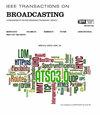A Low-Sampling-Rate Digital Predistortion Method Based on Inverse Filter Signal Recovery for Wideband Power Amplifiers
IF 4.8
1区 计算机科学
Q2 ENGINEERING, ELECTRICAL & ELECTRONIC
引用次数: 0
Abstract
To address the high cost associated with using high-speed and large-acquisition-bandwidth analog-to-digital-converters (ADCs) in the feedback path, a new low-sampling-rate digital predistortion (DPD) method is proposed in this paper. To model the analog bandpass filter (BPF) in the feedback path, a training method for digital finite impulse response (FIR) filter coefficients in a practical band-limited DPD system is proposed, and a filter matrix is constructed in different forms in the case of continuous signal and cyclic signal inputs. The filter matrix provides an extra degree of band-limited power amplifier (PA) model accuracy and robustness. Then, an inverse filter signal recovery (IFSR) method is proposed to recover the full-band output signal of the PA, which can be used to train the predistorter using conventional DPD techniques. Simulation results validates the effectiveness of the IFSR method, demonstrating that the IFSR-DPD method can reduce the ADC sampling rate to 1/10 or less compared to full-rate sampling methods, and decrease the ADC acquisition bandwidth to about 0.3 times that of the original input signal bandwidth. The linearization performance of the IFSR-DPD method is also evaluated on an instrument-based test platform. When the passband and transition band characteristics of the BPF are unsatisfactory, the proposed low-sampling rate DPD method improves the adjacent channel power ratio (ACPR) by 18.67 dB and the error vector magnitude (EVM) by 1.214%, compared to the scenario without DPD.基于反滤波信号恢复的宽带功率放大器低采样率数字预失真方法
针对在反馈路径中使用高速大采集带宽模数转换器(adc)所带来的高成本问题,提出了一种新的低采样率数字预失真(DPD)方法。为了对反馈路径中的模拟带通滤波器(BPF)进行建模,提出了一种实际带限DPD系统中数字有限脉冲响应(FIR)滤波器系数的训练方法,并在连续信号和循环信号输入情况下构造了不同形式的滤波器矩阵。滤波器矩阵提供了额外程度的带限功率放大器(PA)模型精度和鲁棒性。然后,提出了一种逆滤波信号恢复(IFSR)方法来恢复PA的全频带输出信号,该方法可用于训练使用传统DPD技术的预失真器。仿真结果验证了IFSR方法的有效性,表明IFSR- dpd方法可以将ADC采样率降低到全速率采样方法的1/10或更低,并将ADC采集带宽降低到原始输入信号带宽的0.3倍左右。在基于仪器的测试平台上对IFSR-DPD方法的线性化性能进行了评估。当BPF的通带和过渡带特性不理想时,低采样率DPD方法比无DPD时相邻信道功率比(ACPR)提高18.67 dB,误差矢量幅度(EVM)提高1.214%。
本文章由计算机程序翻译,如有差异,请以英文原文为准。
求助全文
约1分钟内获得全文
求助全文
来源期刊

IEEE Transactions on Broadcasting
工程技术-电信学
CiteScore
9.40
自引率
31.10%
发文量
79
审稿时长
6-12 weeks
期刊介绍:
The Society’s Field of Interest is “Devices, equipment, techniques and systems related to broadcast technology, including the production, distribution, transmission, and propagation aspects.” In addition to this formal FOI statement, which is used to provide guidance to the Publications Committee in the selection of content, the AdCom has further resolved that “broadcast systems includes all aspects of transmission, propagation, and reception.”
 求助内容:
求助内容: 应助结果提醒方式:
应助结果提醒方式:


